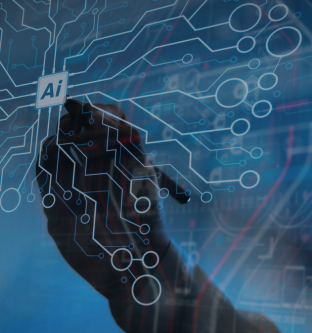Artificial Intelligence, or AI, is taking the world by storm with its pure potential for the future of business. The computer driven support is helpful, but what does it mean for us human marketers?
The opportunities for increased efficiency, better accuracy, and adaptability are impossible to ignore as we move toward this new normal. It has been around for years already, with some of its outputs working in our lives every day. Think, recommendations. When Amazon is pulling information from recent purchases, viewed products, and other data points, it’s AI that’s taking the information and churning out what you’re likely to buy next. The level of prediction that can be reached not only makes the buying process more fluid for the customer, but also increases the likelihood of a purchase!
Though AI itself isn’t necessarily new – accessibility to it has become much easier. With the release of public generators like Jasper and ChatGPT, anyone can get their hands on some AI capabilities (in fact, ChatGPT gained 100 million monthly active users in just two months!) This is leading to some major changes in the marketing industry, and big changes always come with questions for the future. One of the largest is, will it replace people? The short answer is, not entirely. Here’s why there needs to be a human connection involved with utilizing and adapting AI for your work.
Collaboration between human and machine – AI Use Cases
Artificial intelligence can be a powerful tool at your disposal, but it is just that – a tool. It needs to be wielded and managed, which will require some human interaction. As it learns, AI will become much better at catching mistakes, but it doesn’t stop issues from arising entirely. While generative AI has an ability to:
- Generate both written and visual content,
- Develop video and video scripts,
- Increase personalization along customer journeys,
- Improve targeting and segmentation,
- Improve data for better decision making and actionable insights, and
- Enable predictive marketing,
the list is just the beginning, as more advanced AI opportunities will demonstrate. These include use cases like
Real-Time Personalized Customer Journey
This case would leverage synthesis of online and offline touchpoints (i.e. trackable activities, app/platform telemetry, web/chat, heatmaps, social sentiment, service/support engagement and others) to derive next best action for each individual context, not just per channel. It requires AI solutions to predict, or identify, the specific purpose of each engagement session in real time and action upon the needs of the customer in real time. This is consistent with prior Gartner reports indicating that many purchasing decisions are based on overall customer experience rather than price alone.
Real-Time Account and Market Intelligence
AI can be used to scrape information in real-time at scale for all accounts, and not just key accounts, in a programmatic and consistent manner. The information used can come from all engagements with a company, such as call logs, emails, support requests, and so on, but also from public filings (i.e., SEC), press releases, online conversations, and public news involving the company. The purpose of this is to create a scalable solution to gather rich metadata details for the Account that feeds into other statistical models (i.e., Wallet, TAM, etc.) but also classify each Account into a standardized set of market opportunity types or categories. These would be leveraged by programmatic ABM campaigns across various channels and include targeted ad-buys that react with speed and intelligence.
Intelligent Air-Traffic Control (Orchestration AI)
This requires using AI to monitor outbound touches (i.e., email), campaign priorities, and model recommendation outputs to mitigate the risks of over-communication and poor timing. It could be done by leveraging historical open/click/engagement times, implementing intelligent throttling via business governance rules, and by consideration of personalized communication preferences. This “orchestration” AI can help scale operations across multiple channels and AI models by tuning for response/conversion performance.
AI Content Assistant (Dynamic Content Scaler / Web Assistant)
In this case, it’s not just a matter of generating new content, but using LLMs to summarize, translate and reformat existing Marketing content/collateral to the language, tone, role context, account context, cultural context and individual behavioral attributes can help take existing high-detail information and scale it down to fit the individual. For example, with this approach a businessperson may see a “5-minute” summary version of the same content that another person sees in a more detailed/technical “15-minute” variation.
The role of AI in your team
Within each of use case is the potential for correction or guidance by a human counterpart. Generated content may have incorrect information, or perhaps information that is not applicable to your business. The voice of the content could become generic and bland, especially if everyone is using a similar generator – a whopping one in three businesses plan to use ChatGPT to create website content. These generators may come with upgrades that help combat this issue, and incorporate brand voice, but someone still needs to train them to understand it. How about the ideas, and the direction the AI should take? How does the AI know where to start, what data is needed, or who to target? Which rules and controls should it find important? Alignment, guidance, and verification will be necessary on the part of humans. In that regard, it’s not likely humans will be replaced entirely, but it is likely that our positions as we know them will change.
Efficiency is an important benefit that AI brings to the table. The ability to do things faster, with less manpower, is difficult to pass up. However, this factor is what both excites, and concerns, teams. A substantial 77% of people expressed their apprehension that AI could bring about job losses in the imminent future, however, according to World Economic Forum research, AI is also projected to create around 97 million new jobs. These balancing stats indicate that professional roles will be necessary to manage an AI driven world, and that those roles as we know them are changing.
Artificial Intelligence itself should be presented as an augmentation to the team due to its limitations. Whereas AI can only produce work based on the information and data it is given, humans can imagine, anticipate, feel, and judge changing situations, which allows them to shift from short-term to long-term concerns. This difference is what Harvard Business Review dubs ‘Authentic Intelligence”. Existing roles can be adjusted to include expanded skillsets that complement Artificial Intelligence with human Authentic Intelligence. The type of skills required among your team may depend on how you intend to utilize AI. Editing and prompt writing would be important factors for content generation, whereas strategic input will be needed for providing direction on targeting, segmentation, or lead scoring. New roles may also come into effect, with emphasis on experience in machine learning or software specific AI opportunities, training AI, or campaign analysis and optimization.


